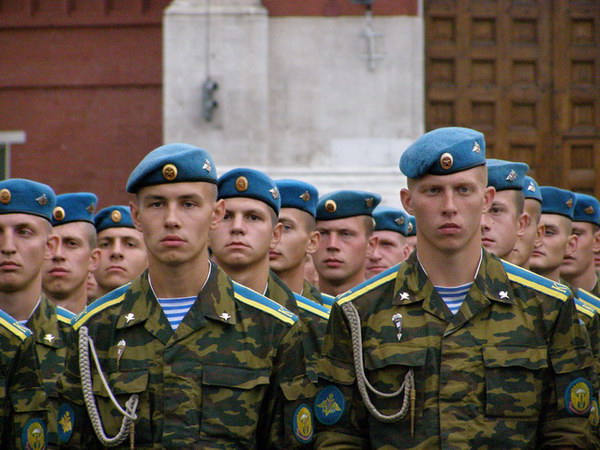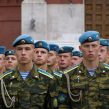
Russia Set to Strengthen Hard Power Options
Publication: Eurasia Daily Monitor Volume: 12 Issue: 146
By:

Russia’s Armed Forces, feeling the strain of unofficial involvement in Ukraine and maintaining higher readiness throughout the crisis, have recently experienced a number of high-profile air force crashes and setbacks for military modernization. The annual VDV Day saw an opportunity to extol the 85th anniversary of the elite Airborne Forces (Vozdushno Desantnye Voyska—VDV), on August 2. The top brass and the Ministry of Defense sent mixed signals regarding the Airborne Forces’ modernization, while revealing surprising plans to recreate a tank army and form a new combined-arms army in the Western Military District (MD) by December 1. These initiatives seem aimed at boosting Moscow’s hard-power options on the country’s periphery, while the latter appears to draw on the success of the role played by Russian tanks in southeastern Ukraine (Interfax, TASS, July 29).
Indeed, the VDV has experienced a good year, with earlier reports concerning the long-awaited introduction of the automated command-and-control system, Andromeda, specifically designed for the Airborne Forces (Krasnaya Zvezda, May 20). This theme was elaborated by the VDV commander, Colonel-General Vladimir Shamanov. In terms of the quantity of modern military hardware entering into the VDV, Shamanov said that the Airborne Forces now have 37 percent of such modern technology in their inventory; this surpasses the overall 30 percent target for 2015 for the entire Armed Forces (RIA Novosti, July 29).
The inward flow of modern military hardware has also been accompanied by plans to expand the VDV from 40,000 personnel to 60,000 as well as slightly modifying its structure and basing. According to Shamanov, the VDV has recently formed five reconnaissance battalions and will establish three more before the end of the year in order to improve reconnaissance capabilities. The first company in each of these battalions is made up of special forces (Spetsnaz) (Interfax, July 30). The VDV has also formed three unmanned aerial vehicle (UAV) companies in another indication of modernization and adjusting its force structure. Shamanov also stated that the Ministry of Defense and the General Staff are discussing possible plans to base the 97th Air Assault Regiment in Dzhankoy, Crimea, as part of the overall planning to boost the defense of the illegally annexed peninsula (Interfax, July 30; RIA Novosti, July 29).
Shamanov also linked the modernization of the VDV’s hardware to continued changes to the structure and capabilities of the Airborne Forces: “We expect to receive, in the foreseeable future, new types of arms. Specifically, six tank companies [will] increase the strike power of the airborne assault formations. We will also receive wheeled vehicles with special combat modules.” That will also include the VDV receiving, by the end of 2015, more than 100 armored vehicles (62 BMD-4M vehicles and 42 BTR Rakushka armored personnel carriers) (Interfax, July 29). Shamanov boasts that in 2016, the VDV will receive the new domestically designed sniper rifle, “Tochnost,” which was on display during the Armiya 2015 military exposition; earlier, he did not rule out the VDV acquiring foreign-purchased sniper rifles (Rg.ru, July 30).
These developments in introducing high-tech systems in the VDV are driving the campaign to increase the number of contract personnel (kontraktniki) in the VDV. Shamanov wants the overall percentage of kontraktniki to reach 80 percent. However, he currently prides himself in the fact that the VDV has ten battalions staffed entirely by kontraktniki (Krasnaya Zvezda, July 30; TASS, July 30). The VDV commander links the presence of increased numbers of kontraktniki and his ten fully staffed battalions to the need to potentially deploy in Central Asia due to a worsening situation in Afghanistan or other contingencies. However, he again reminded his interviewer of his controversial comments earlier this year, noting that the VDV units do not require visas to deploy, only an order from the commander-in-chief.
While the VDV serves in the role of “first in” and is lightly armed and easier to move, the announced plans to modify the battle order of the Ground Forces in Western MD is more difficult to explain. By the end of the year, the defense ministry plans to set up a new 20th Combined-Arms Army; it will consist of the 9th Tank Brigade, based in Nizhniy Novgorod, with other tank and motor-rifle brigades for this army formed from scratch since the bulk of the current 20th Army’s units were transferred into the newly formed 1st Guards Tank Army. The 1st Tank Army includes the 4th Guards Kantemirovskaya Tank Division, the 2nd Guards Tamanskaya Motor-Rifle Division, the 6th Tank Brigade and the 27th Guards Sevastopolskaya Motor-Rifle Brigade. Reportedly, the two new armies will be similar, with each having a reconnaissance brigade, an air defense brigade, a material and technical support (MTO) brigade, missile and artillery units, a helicopter regiment, reconnaissance, and attack UAV units. The 1st Tank Army, however, will have more tanks than the 20th Combined-Arms Army, though the latter will have greater numbers of infantry fighting vehicles. These new armies, according to TASS reports, will be first in line to receive the new Armata tanks and Kurganets infantry fighting vehicles. Their re-equipment with new hardware will start in 2016–2017, a General Staff source indicated (TASS, July 29).
The creation of the tank army in Western MD has left a number of Russian military analysts puzzled. The head of the military laboratory of the Institute for Economy in Transition, Colonel (retired) Vitaly Tsymbal fails to see any sense in forming the tank army. Tsymbal notes that such decisions should be easy to explain based on the known planning documents of the Armed Forces. However, in his view, the National Security Strategy and the latest Military Doctrine (2014) offer no basis for this initiative. Russian military expert Viktor Murakhovsky believes that the new tank army is a purely symbolic gesture, and consistent with similar Soviet-style gestures previously undertaken by Defense Minister Sergei Shoigu. Analyst Aleksandr Golts links the tank army move to wider doubts that have crept into General Staff thinking as a result of the importance of the tank as a platform in Donbas. In his view, the move does not actually signal increased risk of conflict on the periphery of the North Atlantic Treaty Organization (NATO) (Gazeta.ru, July 30).
While the modernizing theme is dominant in the VDV’s force development, it seems the Ground Forces’ efforts to boost hard power options are less than clear. But the appearance of a “Tank Army” may be a sign of underlying disagreement in the General Staff concerning “network-centric” or “tank-centric” approaches to future conflict.




